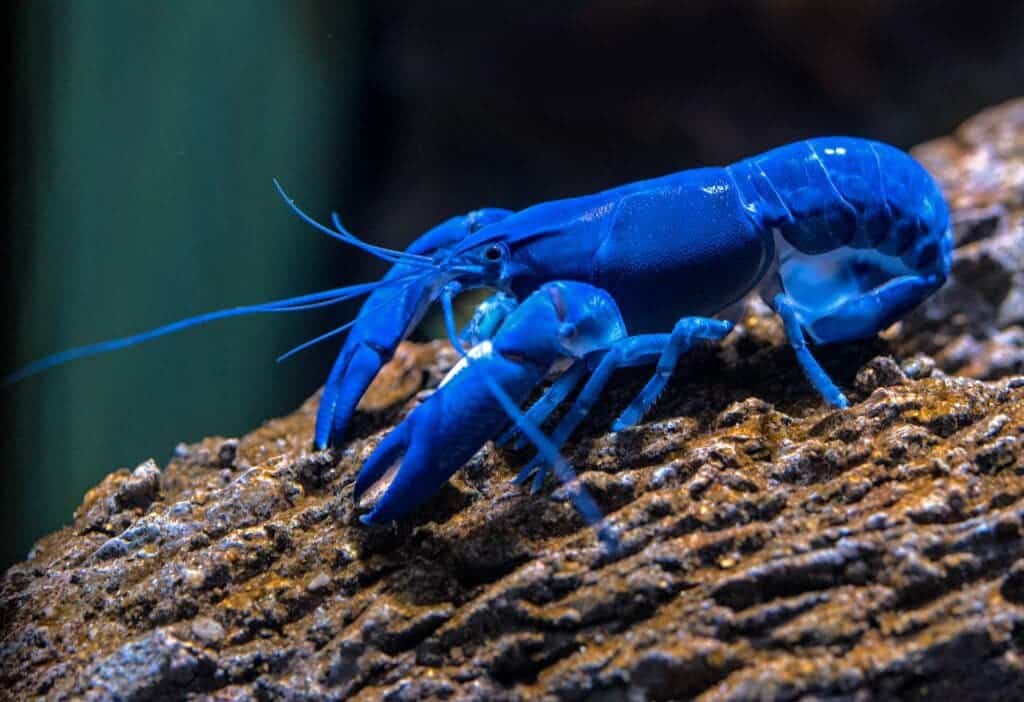In May 2021, the workers at Red Lobster restaurant in Virginia spotted a peculiar lobster in their daily supply. Due to its unique orange and black freckled shell, the restaurant team decided to name the lobster “Freckles” and then contacted their support team about whether or not they should serve this lobster as dinner.
Fortunately for Freckles, the Red Lobster support team realized that Freckles was actually a rare calico lobster and decided to rescue it instead of simply using it as food. They connected their restaurant team with Virginia Living Museum with some help from Ohio-based Akron Zoo.

Calico is a rare coloration of lobster where it has a distinctive black and orange mottled color pattern – also called a “cinnamon” lobster. They are much rarer than the common green or brown lobsters. In fact, the odds of the mutation responsible for calico lobsters happening are about 1 to 30 million.
The mutation causes certain cells to produce more or less of certain pigments, resulting in a mottled appearance. This genetic variation is naturally occurring and is not caused by any external factors such as environment or diet.
Currently, Freckles is enjoying a healthy life at the Virginia museum; it wasn’t transferred to a natural habitat because sadly, the unique shell coloring which makes lobsters like Freckles rare also makes it easy for their predators to spot and hunt them. Unlike the usual brown shell, the bright colors render a lobster unable to hide and gel with its surroundings. Turns out, being rare is not always a good thing.
However, calico is not the only rare and eye-catching lobster coloration that deserves your attention. Recently, a Massachusetts-based fisherman found a half-black half-orange lobster in Maine, and in the past, a few other unique lobsters with albino and cotton candy-colored shell colors have also been discovered.
So from where do these rare lobsters get their unique colorful shells, and what are some other secrets which make lobsters one of the most exciting beings on our planet?
The science behind rare colored lobsters
The shell color in lobsters is managed by astaxanthin, a reddish carotenoid pigment molecule that decides a lobster’s appearance based on the protein to which it binds. In typical lobsters, astaxanthin is attached to a protein named crustacyanin, and this combination results in brown shell color. However, when lobsters are boiled to make a dish, the bonding between crustacyanin and astaxanthin breaks, leaving the latter free, and this is why lobsters turn red when they are heated.
In the case of calico lobsters and others, the astaxanthin pigment binds with proteins other than crustacyanin. These proteins allow the pigment molecules to absorb and emit light of different wavelengths, and the emitted light further decides the resultant pigment and shell color. Some proteins lead to a yellowish appearance, some proteins give the lobster a dark blue body, and sometimes when light of multiple wavelengths is emitted, the lobster shell has a calico, burnt orange, or split-colored look.
It’s not all genetics. Sometimes the shell color is also affected by the type of food a lobster consumes. Usually, lobsters feed on shrimp, little fish, and crabs, these aquatic animals are loaded with reasonable amounts of astaxanthin but in cases where a lobster feeds only on smaller fish, it has low astaxanthin levels. The low pigmentation is believed to be one of the reasons why a lobster has a light blue, white, or cotton candy-colored shell.
Some experts believe that the unique shell colors in rare lobsters might be caused due to genetic mutations. They assume that these mutations lead to anomalies in the proteins that bind with astaxanthin, resulting in different shell colors.
Rarest lobsters ever discovered
The calico lobster is considered among the three rarest lobster types, but it’s not the rarest one. So here is a list of the most peculiar and rare lobsters other than calico.

Albino lobster
Also called ghost lobsters or crystal lobsters, albino lobsters are the rarest of all. It’s been almost a year since the last albino lobster sighting. Last year, in February 2021, James Hook Lobster Corporation caught the “1 in 100 million” albino lobster from the coast of Maine.
The shells of these lobsters lack astaxanthin pigment entirely, which gives them a grayish transparent look. In cases where the absence of astaxanthin is caused due to genetic mutation, then the albino lobster is believed to have leucism, an abnormal condition (found in other animals) in which pigmentation on the skin is reduced.
Pastel lobster, a.k.a cotton candy
Similar to ghost lobsters, cotton candy lobsters also occur once in every 100 million individuals. According to professor Michael Tlusty who teaches sustainability at the University of Massachusetts’ School of Environment, the unicorn-colored cotton candy lobsters do not occur very frequently; if you catch one today, you may have to wait for up to five years before you see a pastel lobster again.
Interestingly, a fisherman named John McInnes in Casco Bay, Portland, caught the same cotton candy lobster twice, the first time in October 2018 and the second time in July 2019.
Yellow and orange lobsters
Both of these lobster colourings are as rare as the calico one (one in 30 million), and both of them lack the protein which is essential for turning their shells brown. If you are looking forward to seeing these vibrant crustaceans in real life, you can visit the New England Aquarium in Boston.
The aquarium exhibits a yellow lobster that was originally rescued in 2017 and an orange one that arrived there from Nova Scotia in 2018.
Blue lobster
This lobster may have the most exotic look after the calico, but it’s the least rare lobster on our list, as researchers estimate that you can find a blue lobster in every two million brown ones. Due to a strange genetic anomaly, a large number of astaxanthin-wrapping proteins are produced in the body of a lobster.
Because of the excess of protein, the number of blue crustacyanin molecules outnumbers the astaxanthin pigment molecules, and therefore the lobster shell looks blue.
Some less-known facts about lobsters
Whether rare or not, lobsters are indeed interesting creatures, so here are some facts that will bring you closer to the secretive life of lobsters:
- Lobsters can live for over 100 years, and they can regrow entire limbs in relatively short amounts of time.
- Lobster blood is blue. This is due to the presence of copper, which helps carry oxygen in the lobster’s body.
- A lobster’s eyes reflect light beams instead of refracting the same as human eyes. So in bright light conditions, lobsters are almost blind; however, in low light conditions, their eyes work like an ‘x-ray’ in the murky depths of the ocean. Whereas human eyes are composed of cones and rods, lobster eyes have thousands of tiny squares, and each square tube directs the light to the same focal point. So although lobsters aren’t capable of seeing images, they are very good at detecting motion. The unique eyes of lobsters have served as an inspiration for researchers to develop X-ray scanners and various other X-ray-based technologies.
- Lobsters are nocturnal beings, they rest during the day and come out of their hiding mostly at night searching for food. So, if you plan on being a successful lobsterman, all you need is an excellent marine flashlight, and you better get comfortable with diving at night.
- Before the 1800s, in the colonial era, lobsters were so abundant that they emerged as the go-to solution for people with poor financial conditions to meet their daily protein requirements. The sheer availability of lobster made it so cheap that they became a standard meal for prisoners at one point.
- Recently, a study conducted by researchers from the London School of Economics and Political Science revealed that lobsters, crabs, and octopuses can also sense feelings like pleasure and pain. In the past also, studies conducted in different parts of the world have highlighted that lobsters do feel pain when they are boiled alive. Taking these studies into consideration, in 2020, the Swiss government announced a complete ban on the practice of boiling lobsters alive.
- There are no known standards for measuring the intelligence of a lobster but given you can fit their brain on the tip of a ballpoint pen, this certainly doesn’t make them the most intelligent creatures in the sea.
Lobsters may have a teeny-tiny brain, but their lifestyle and unique characteristics have grabbed the attention of various brainy scientists and researchers. So the next time you come across a rare lobster, don’t judge him by his brain size but the science behind its gorgeous looks.






